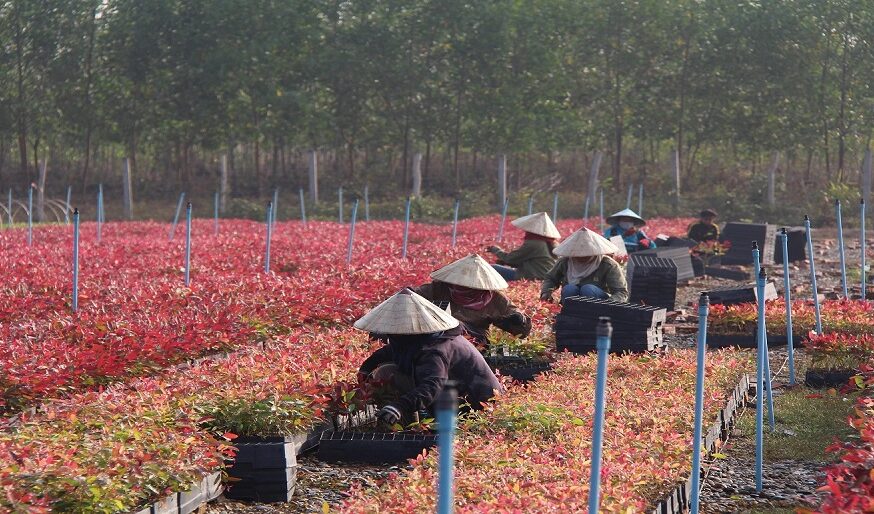Regenerative agriculture holds powerful climate mitigation potential. These methods simultaneously improve soil health and help sequester atmospheric carbon, proving that farming can be a solution to – not a driver of – climate change.
Recognising the urgent need for both, Philipson Estates and project developer, ecometric, have introduced regenerative agriculture practices to Blaston Farm in Leicestershire, England. With the support of independent agronomists, Indigro Ltd, 230 hectares are now being farmed regeneratively.
To improve soil health and promote biodiversity, Blaston Farm uses a range of regenerative techniques. These include direct drilling, introducing diverse crop rotations and integrated livestock grazing – all of which help to capture and store additional carbon in the soil.
From this additional carbon, the project generates soil carbon certificates. Blaston Regenerative Farming is the first project in the UK to earn certificates by directly measuring soil organic carbon gains over a production cycle. Today, the sale of these certificates is the farm’s second largest income stream and provides an alternative to EU subsidies in a post-Brexit Britain. Recently, the project was validated by the Regen Network meaning that Blaston Farm’s soil carbon certificates will be followed by carbon credits – a significant milestone for establishing widespread credibility for soil carbon projects.
THE SECRET OF SOIL
While we tend to recognise the role of the oceans and trees in carbon capture, we often forget the huge potential of the soil beneath our feet – the top 30 cm of the Earth’s soil holds nearly twice as much carbon as the entire atmosphere.
However, as with trees, we must not take soil’s ability to capture carbon for granted. The changing climate poses a serious threat to carbon-rich topsoil. Degradation limits its ability to capture and store carbon, which in turn, reduces agricultural output. As the global population exceeds eight billion, maintaining (and increasing) the production capacity of soil is critical for future food security.
With so many mouths to feed, it is understandable that much of the world has turned to intensive agriculture and monocropping over the past decades. However, this approach is short-sighted. We cannot endlessly strip the Earth’s soil of nutrients without consequence. We need to harness alternatives that ensure healthy soils and high yields for the long term.
POSITIVE IMPACTS FOR CLIMATE AND NATURE
Since transitioning to regenerative agriculture, Blaston Farm sequestered 5,000 tonnes of CO2e (net of all on farm emissions, plus a permanence buffer) in just one year. If we tap into soil’s immense potential, it can contribute significantly to climate mitigation. In addition to carbon removal, the project contributes to mitigation by:
1. Soil health
The starting point for the project was to focus on minimising soil disturbance. Heavy cultivations and ploughing had led to a reduction in soil organic matter. Direct drilling was introduced at Blaston Farm after the first cover crop was established. All arable crops are now direct drilled, leading to a reduction in emissions, reduced soil erosion and an overall increase in soil health.
2. Building resilience
Healthy soil makes for a more biodiverse ecosystem with greater resilience against the climate crisis. On Blaston Farm, this is visible through a 7-fold increase in its worm count (a strong indicator of soil health). In turn, this has created a more stable soil structure and improved the farm’s drainage and nutrient cycling.
3. Carbon sequestration
Soil left exposed to the elements will erode and potential plant nutrients leach into watercourses. Permanently covering the soil using a range of species allows the soil to be protected and helps the build-up of soil organic matter. The cover not only protects the soil, reducing CO2 release, but the cover crop also draws down carbon from the atmosphere.
4. Boosting biodiversity
To maintain natural ecosystem diversity, regenerative agriculture uses diverse crop rotations. As well as this, Blaston Farm reintroduced livestock into its arable rotations. The livestock improve the nutrient balance of the soil, while grasses encourage soil health and reduce weed burden. Blaston Farm has also piloted habitat strips to support predators and reduce pesticide usage.
5. Improved yields with fewer fertilisers
Catch crops allow green cover between harvest and autumn drilling. Companion crops and permanent understories such as white clover reduce the need for insecticides and herbicides. These leguminous plants fix nitrogen in the soil so it is plentifully available for the main cash crop.
6. Preventing pollution
Agricultural run-off transports nitrogen-rich fertilisers directly into nearby rivers and lakes. Once in the water, nitrogen contributes to a phenomenon known as eutrophication which presents as a green, film-like layer of algae covering the water’s surface. This prevents sunlight from reaching below the water’s surface which is detrimental for fish and aquatic plants.
However, when soil is healthy, it requires fewer fertilisers to generate large yields meaning fewer nitrates are washed into the surrounding waterways. Improving soil health on agricultural land benefits the health of aquatic ecosystems too.
SETTING A REGENERATIVE PRECEDENT
Soil carbon certificates now make up a large proportion of Blaston farm’s income, second only to wheat. At the same time input costs have decreased without any reduction in yield. This demonstrates how accessing carbon finance can be an economically viable option for farmers in the UK. Payment for measured increases in soil organic carbon provides a strong incentive for more farmers to adopt regenerative agriculture approaches in the near future.
ASSURANCE
The Blaston Regenerative Farming project has been advised by Indigro Ltd and Fisher German. Informed by these leading specialist agronomists, the project operates with a high degree of assurance in its nature positive outcomes.
Verification
Independently verified by ecometric, the project demonstrates a proven commitment to high standards. ecometric carried out detailed soil analysis across all fields in the project area before the start of the 2021 growing season. It then repeated the measurement a year later to quantify the precise volume of carbon dioxide absorbed over the production cycle. These results were then cross-checked using ecometric’s satellite imagery AI analytics. The total farm emissions, including permanent pasture and animal production, were then subtracted from the carbon gain in the arable soils. This revealed that Blaston Farm was indeed climate-positive and had sequestered a net volume of 5,000 tonnes of CO2e over the course of the year.
Additionality
Without this project, thousands of tonnes of CO2 would still be present in the earth’s atmosphere. Moreover, the soil at Blaston Farm is in a better state of health following the implementation of regenerative agricultural methods, as evidenced by observed improvements across a number of key indicators (soil organic carbon against the baseline at the project’s start date, structure, worm count etc.). This has created additional co-benefits for biodiversity that work to build the overall resilience of the farmland ecosystem against degradation and erosion.
Permanence
While reversals of soil carbon gains are possible, it is a slow and uncommon phenomenon. Even if land is mismanaged for a year (e.g. it is overgrazed or crops are not rotated), carbon that has previously been sequestered is not re-released. It would simply mean that no additional carbon could be drawn down in that production cycle. The economic incentives offered by soil carbon certificates directly support the engagement in regenerative agriculture, mitigating capital investment and perceived risks associated with the adoption of new approaches. Philipson Estates have committed to refrain from practices which disturb the soil over a ten-year permanence period, throughout which they will be subject to ongoing monitoring to verify that soil organic carbon levels have been maintained. Over this period, it is anticipated that regenerative practices will become embedded as the farm experiences the benefits of healthier soils, including yields achieved and lower input costs (such as fertiliser or pesticides) that are also positive in terms of profitability.
Share this article



